
Kienbock’s Disease as a Cause of Wrist Pain in Young Adults

Kienbock’s Disease
A condition that may plague adults, particularly males in the 20-40 year age range, is avascular necrosis of the lunate. This has been termed Kienbock’s disease in reference to the doctor who first diagnosed the disease in 1910. This may be a major source of wrist pain and disability in the short term, with entrapment neuropathy and degenerative arthritis in long-standing cases. Clinically, a patient may exhibit tenderness upon palpation of the lunate, limited wrist movement, swelling and weakness of grip (2).
It often occurs in the patient’s dominant hand, although it may be bilateral. There may be a history of antecedent trauma, though many cases appear to be idiopathic. A strong association with a short ulna (negative ulnar variance) is noted in a high percentage of patients. It has been speculated that this anatomic configuration may exert excessive force on the lunate from the radius and precipitate vascular compromise. In any case, there is a disruption of blood flow to the lunate and subsequent necrosis.
Imaging
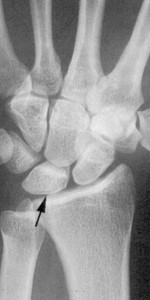
Radiographically the appearance of the disease will vary with the stage of involvement. Four stages are described radiographically. In stage 1, there may be no plain film findings. Possible appearances at this stage, however, include a fracture line or a relative increase in osseous density, largely due to osteopenia of surrounding carpal bones from disuse (1). Figure 1 demonstrates a normal density lunate with a subtle radiolucent fracture line at the radial articular margin of the lunate.
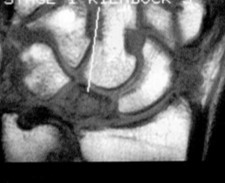
An MRI examination or radionuclide bone scan will show earlier changes and be positive in this stage. The MRI exam will highlight decreased signal on the T-1 weighted images (Figure 2) with increased signal intensity on the T-2 and fat-suppressed images and possible hypointense fracture lines (Figure 3). On the bone scan, an accumulation of the radionuclide tracer in the lunate can be seen. Figure 4 demonstrates the dark radiotracer uptake generally in the left wrist.
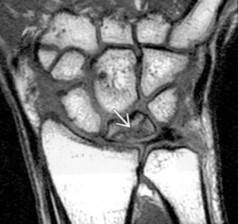
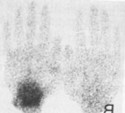
The MRI exam will highlight decreased signal on the T-1 weighted images (Figure 2) with increased signal intensity on the T-2 and fat-suppressed images and possible hypointense fracture lines (Figure 3). On the bone scan, an accumulation of the radionuclide tracer in the lunate can be seen. Figure 4 demonstrates the dark radiotracer uptake generally in the left wrist.
Stage 2
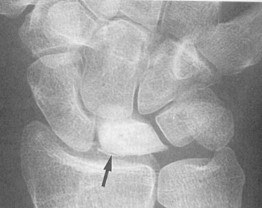
Stage 2 features sclerosis of the lunate on plain film x-ray, with possible subtle collapse and irregularity of the articular surfaces (Figure 5).
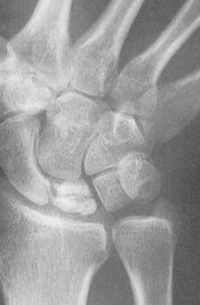
Stage 3
Stage 3 involvement will reveal fragmentation and progressive collapse of the lunate (Figure 6), possibly with an overall noticeable decrease in size (Figure 7, MRI sagittal T-1 image). In the late stages, there will be proximal migration of the capitate, possibly with scaphoid rotation.
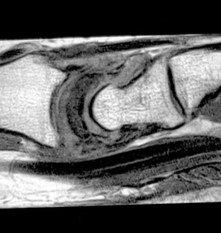
Stage 4
Stage 4 will feature findings previously described, with superimposed degenerative changes at the radiocarpal and intercarpal articulations.
Treatment
The recommended treatment, particularly in stage 1, is conservative. There may be suggested surgical shortening of the radius with a wedge osteotomy, or revascularization procedure, in stage 2 or 3. In stage 4, radical surgical removal of the proximal carpal row or osseous fusion may be recommended. A prosthetic lunate implant or bone graft procedures may be an option in some cases.
References:
1. Yochum TR, Rowe LJ. Essentials of skeletal radiology. 3rd edition. Baltimore: Williams and Wilkins. 2005.
2. Stoller D. W.: Magnetic Resonance Imaging in Orthopaedics and Sports Medicine, ed 2. Philadelphia, J. B. Lippincott Company 1993.
Plain film x-rays were provided courtesy of Dr. Terry Yochum DC, DACBR.

















